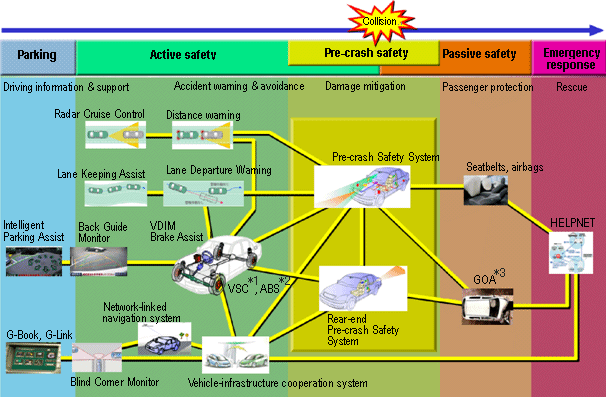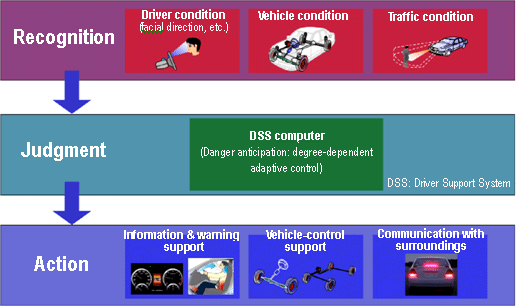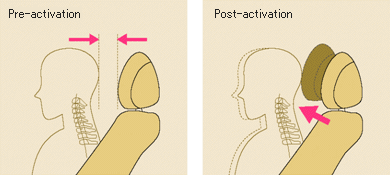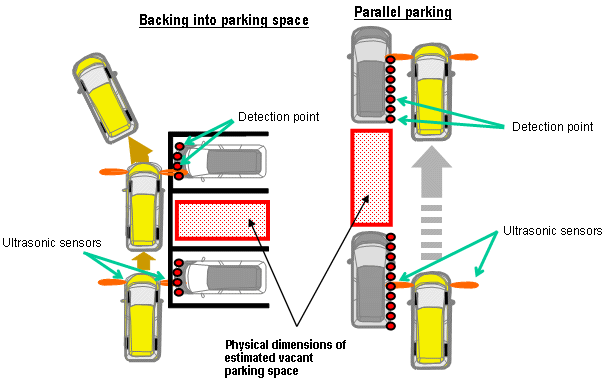Aug. 25, 2006
Toyota Strengthens Efforts to Develop Safe Vehicles
―Integrated Safety Management Concept Forms Base of New Safety Technologies―
Tokyo ― TOYOTA MOTOR CORPORATION (TMC) announced today its Integrated Safety Management Concept, an expression of the direction of Toyota's technology development for furthering the development of safe vehicles. TMC also announced new safety technologies based on this concept that are to be featured in the LS460, Lexus' new flagship sedan scheduled for launch this September.
As a part of its efforts to realize sustainable mobility, Toyota intends to strengthen its traffic safety initiatives in the future through: 1) the development of even safer vehicles and technologies, 2) participation in the creation of a safe traffic environment and 3) activities designed to educate people in traffic safety, thereby contributing to the complete elimination of traffic casualties, which can be viewed as the ultimate hope of a society that values mobility.
Toyota's safety technology and vehicle development aims to provide optimal driving support based on driving conditions, not only by integrating individual safety technologies and systems in the vehicle, but also by adopting an infrastructure- respondent system (road-to-vehicle) and using information obtained from vehicles other than the driver's (vehicle-to-vehicle), to enhance synergistic effects.
Higher levels of safety are being pursued in five types of situations categorized by the degree of risk of an accident: parking, active safety, pre-crash safety, passive safety and emergency response. By increasing such integration even further in the future, Toyota seeks to reduce dangers related to vehicle use in the pursuit of vehicles that do not cause accidents.
Integration of individual technologies and systems

*2 Anti-lock Brake System
*3 Global Outstanding Assessment
Under this integrated management, information detected by various sensors in the vehicle, including information on the driver's condition and the vehicle's behavior, is accumulated in the DSS (Driver Support System) computer. This computer determines the optimal support to give the driver in order to prevent a dangerous situation from occurring, and it controls the various technologies and systems concerned.
Diagram of Control via DSS

Based on the Integrated Safety Management Concept, Toyota has improved safety technologies for pre-crash safety, active safety and parking.
Pre-crash Safety
The Pre-crash Safety System uses millimeter-wave radar to detect vehicles and obstacles on the road ahead and help reduce the severity of unavoidable collisions. Toyota was the first in the world to commercialize this system in February 2003 with its adoption on the Harrier. Since then, the addition of a forward-oriented camera for image recognition has enhanced the detection capability. In March 2006, Toyota added a driver monitoring system that uses a camera in the cabin.
The new Pre-crash Safety System announced today uses improved millimeter-wave radar and a newly developed stereo camera to detect pedestrians and support emergency collision evasion maneuvers by the driver. Rear millimeter-wave radar has also been added that detects a vehicle approaching from behind and issues a warning to the vehicle. Through these measures, Toyota is making advances in preventing accidents to the greatest extent possible.
■Pre-crash Safety System
1. Enhanced Frontal Pre-crash Safety System with new Pedestrian Detection and Collision Avoidance Support Functions
The new Pre-crash Safety System features the world's first* fusion of millimeter-wave radar with enhanced detection functions and a newly developed stereo camera. Information obtained by the millimeter-wave radar is combined with three-dimensional object detection information from the stereo camera to detect not only vehicles and obstacles, but also pedestrians. A near-infrared projector located in the headlights supports nighttime detection.
The system retracts the seatbelts and warns the driver when it determines a high possibility of a collision. If the driver does not brake, the Pre-crash Brakes are applied to reduce collision speed.
When the driver takes emergency evasive maneuvers, VGRS (Variable Gear Ratio Steering) and AVS (Adaptive Variable Suspension) optimally control the steering gear ratio and suspension to support the driver's measures. In addition, the system cooperates with the VDIM (Vehicle Dynamics Integrated Management) to assist the maintenance of vehicle stability.
* As of the end of July 2006, according to TMC survey


2. World's First* Pre-crash Safety System
A millimeter-wave radar device installed in the rear bumper detects a vehicle approaching from behind. If it is determined that there is a risk of collision, the hazard lights flash to warn the driver of the rear vehicle. If the vehicle continues to approach, sensors implanted inside the front headrests of the forward vehicle detect the position of both the driver's and front passenger's heads, and prior to impact the Pre-crash Intelligent Headrests shift to appropriate positions to reduce the risk of whiplash injury sustained upon collision.
* As of the end of July 2006, according to TMC survey



Active Safety
■Radar Cruise Control with All-speed Tracking Function
A newly developed cruise control support system monitors the preceding vehicle, maintaining a fixed distance according to the preceding vehicle’s speed; this system can maintain continuous control, ranging from stop (0km/h) to high speed (100km/h).
In contrast to an earlier system that sustained control in two separate speed ranges―low speed (0–30km/h) and high speed (40–100km/h), the new system can maintain continuous control even during the repeated starting and stopping of a vehicle in situations such as highway traffic congestion, thereby substantially reducing the burden on the driver.
Parking
■Intelligent Parking Assist
In September 2003, Toyota commercialized the world's first Intelligent Parking Assist system, which supports steering operations when parallel parking or backing into a parking space, and adopted it for the Prius. In November 2005, the system gained the ability to process video images from a rear camera to recognize the location of parking space lines*1 and set the target parking position.
The new Intelligent Parking System announced today adds functions that use newly developed front ultrasonic sensors (a world's first*2) to detect other parked vehicles. Based on information gained, the new system can estimate the physical dimensions of the vacant parking space and set the target parking position. In combination with the other functions, this greatly simplifies the driver's own processes of setting the parking position and making adjustments, enhancing usability.
*1 According to color contrasts
*2 As of the end of July 2006, according to TMC survey













